Abstract
Campylobacter pyloridis was isolated from 77% of 220 (35%) unselected adults undergoing gastroscopy. Isolation was significantly associated with histological gastritis (p less than 0.0001), duodenal ulcer (p less than 0.0001), and to a much lesser extent, with gastric ulcer (p less than 0.05). The relation between the isolation of C pyloridis and peptic ulcer seemed to be independent of coexisting gastritis. In those with no endoscopic or histological evidence of disease there was no relation between isolation and increasing age. Antibody responses to a whole cell sonicate of a strain of C pyloridis were measured by means of an enzyme linked immunosorbent assay (ELISA). Increased IgA (p less than 0.0001) and IgG (p less than 0.0001) antibody titres were found in patients with C pyloridis. Peptic ulceration or gastritis were present in 78% and 100% of patients with a high concentration of IgG and IgA, respectively, but in only 9% and 18% of those with low titres. These results provide further evidence for a possible pathogenic role of these organisms in gastric disease and suggest that immunological markers of their presence might be useful non-invasive indicators of disease.
Full text
PDF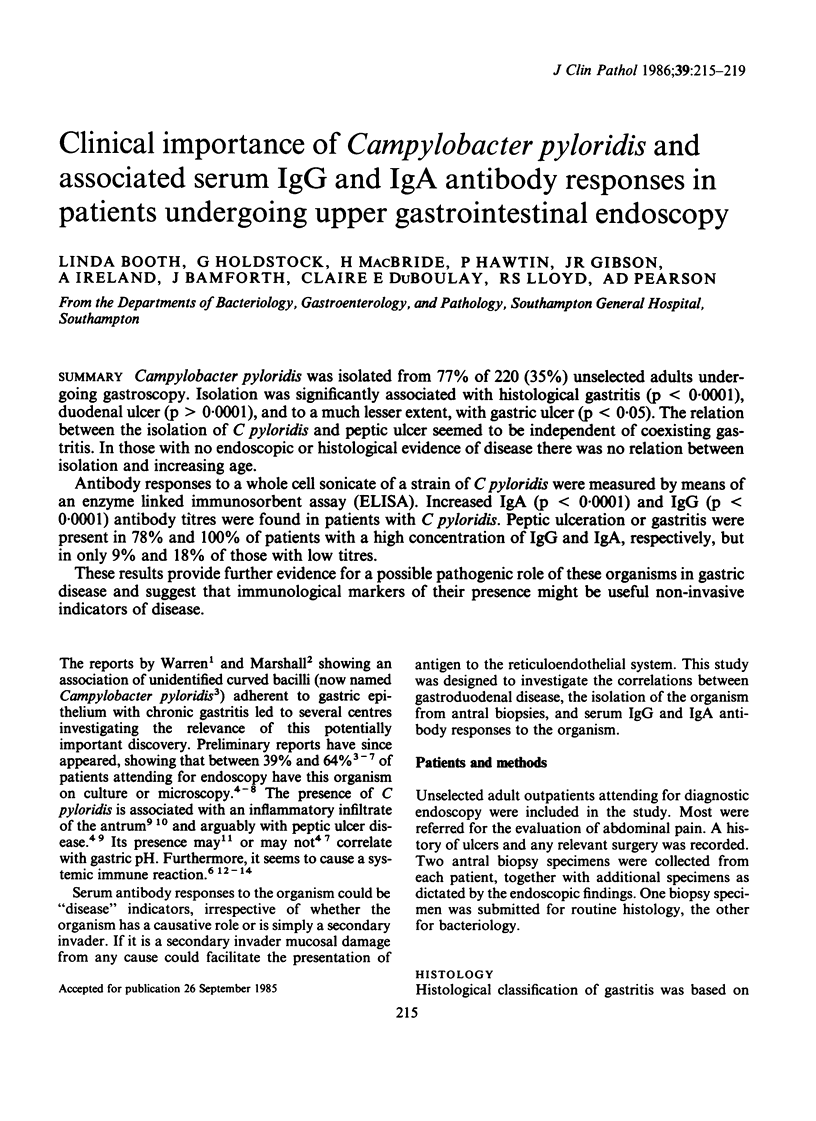
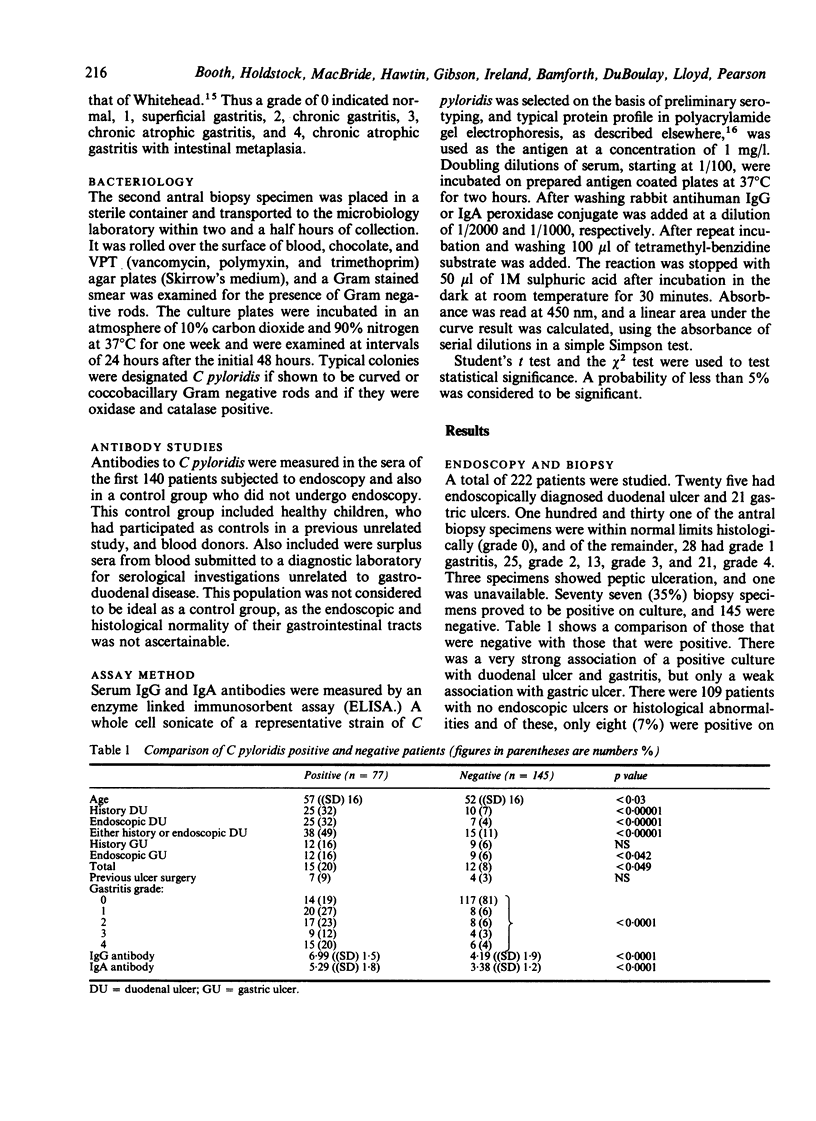
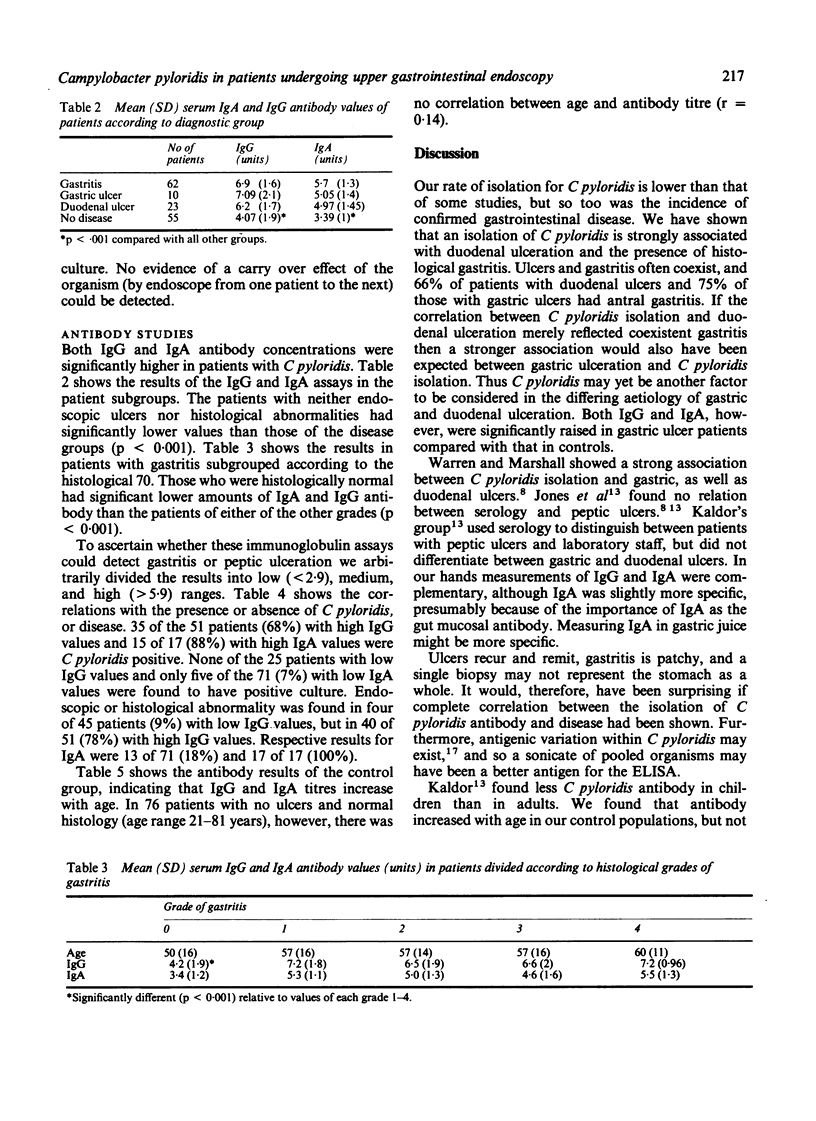
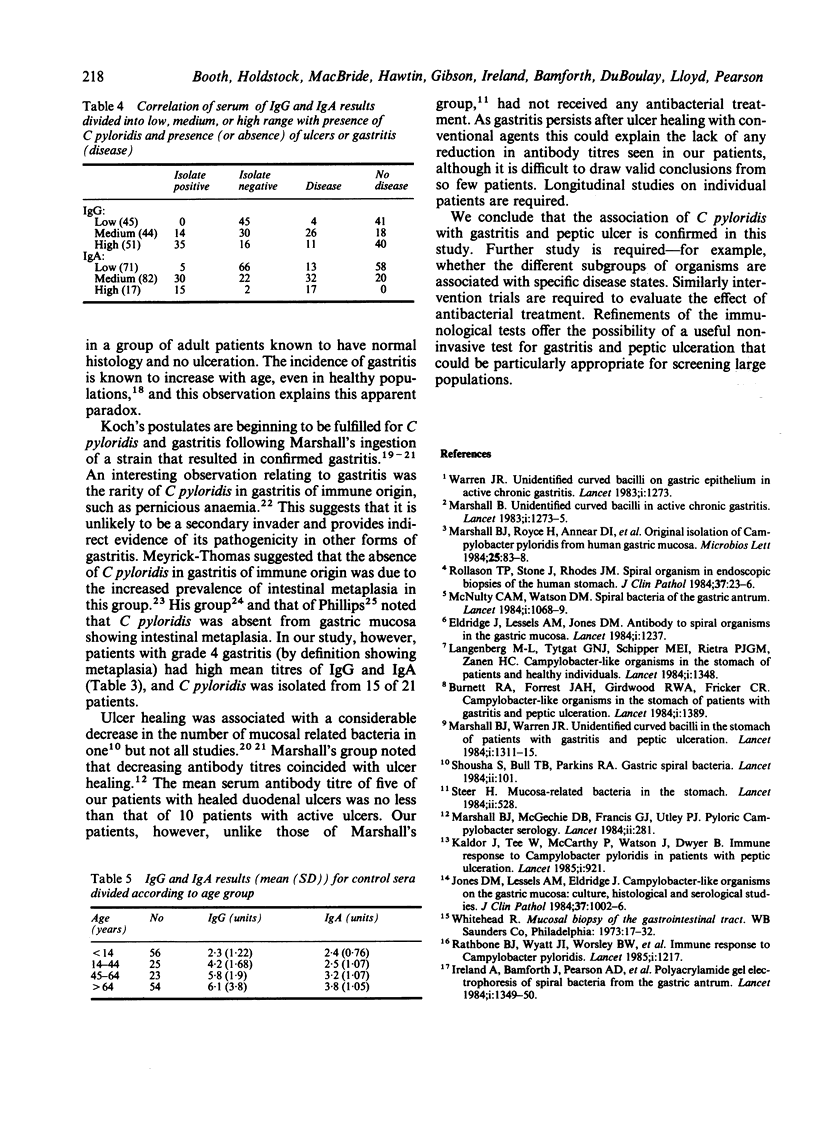
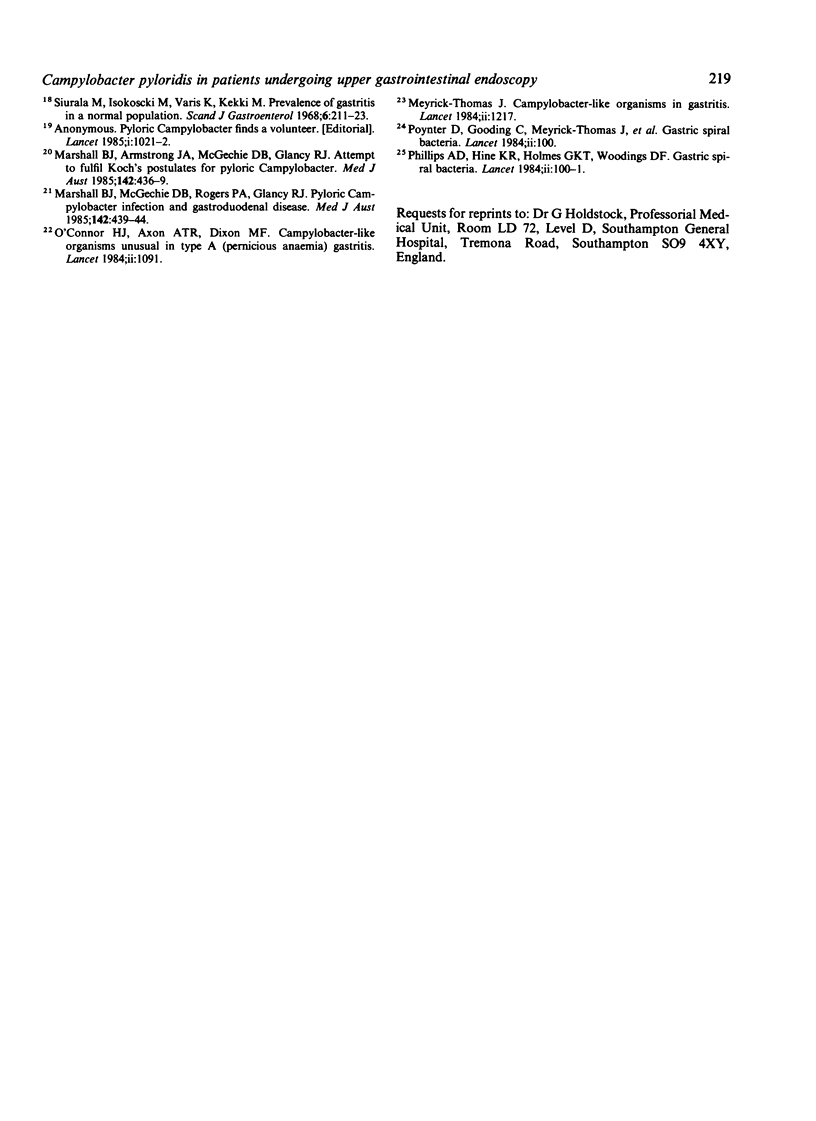
Selected References
These references are in PubMed. This may not be the complete list of references from this article.
- Beaney R. P., Lammertsma A. A., Jones T., McKenzie C. G., Halnan K. E. Positron emission tomography for in-vivo measurement of regional blood flow, oxygen utilisation, and blood volume in patients with breast carcinoma. Lancet. 1984 Jan 21;1(8369):131–134. doi: 10.1016/s0140-6736(84)90063-1. [DOI] [PubMed] [Google Scholar]
- Campylobacter-like organisms in the stomach of patients and healthy individuals. Lancet. 1984 Jun 16;1(8390):1348–1349. [PubMed] [Google Scholar]
- Curative consolidation chemotherapy. Lancet. 1984 Jun 23;1(8391):1389–1390. [PubMed] [Google Scholar]
- Eldridge J., Lessells A. M., Jones D. M. Antibody to spiral organisms on gastric mucosa. Lancet. 1984 Jun 2;1(8388):1237–1237. doi: 10.1016/s0140-6736(84)91716-1. [DOI] [PubMed] [Google Scholar]
- Gastric spiral bacteria. Lancet. 1984 Jul 14;2(8394):100–101. [PubMed] [Google Scholar]
- Jones D. M., Lessells A. M., Eldridge J. Campylobacter like organisms on the gastric mucosa: culture, histological, and serological studies. J Clin Pathol. 1984 Sep;37(9):1002–1006. doi: 10.1136/jcp.37.9.1002. [DOI] [PMC free article] [PubMed] [Google Scholar]
- Kaldor J., Tee W., McCarthy P., Watson J., Dwyer B. Immune response to Campylobacter pyloridis in patients with peptic ulceration. Lancet. 1985 Apr 20;1(8434):921–921. doi: 10.1016/s0140-6736(85)91687-3. [DOI] [PubMed] [Google Scholar]
- Marshall B. J., McGechie D. B., Francis G. J., Utley P. J. Pyloric campylobacter serology. Lancet. 1984 Aug 4;2(8397):281–281. doi: 10.1016/s0140-6736(84)90318-0. [DOI] [PubMed] [Google Scholar]
- Marshall B. J., McGechie D. B., Rogers P. A., Glancy R. J. Pyloric Campylobacter infection and gastroduodenal disease. Med J Aust. 1985 Apr 15;142(8):439–444. doi: 10.5694/j.1326-5377.1985.tb113444.x. [DOI] [PubMed] [Google Scholar]
- McNulty C. A., Watson D. M. Spiral bacteria of the gastric antrum. Lancet. 1984 May 12;1(8385):1068–1069. doi: 10.1016/s0140-6736(84)91469-7. [DOI] [PubMed] [Google Scholar]
- O'Connor H. J., Axon A. T., Dixon M. F. Campylobacter-like organisms unusual in type A (pernicious anaemia) gastritis. Lancet. 1984 Nov 10;2(8411):1091–1091. doi: 10.1016/s0140-6736(84)91523-x. [DOI] [PubMed] [Google Scholar]
- Pearson A. D., Ireland A., Bamforth J., Walker C., Booth L., Hawtin P., Holdstock G., Millward-Sadler H. Polyacrylamide gel electrophoresis of spiral bacteria from the gastric antrum. Lancet. 1984 Jun 16;1(8390):1349–1350. doi: 10.1016/s0140-6736(84)91837-3. [DOI] [PubMed] [Google Scholar]
- Rathbone B. J., Wyatt J. I., Worsley B. W., Trejdosiewicz L. K., Heatley R. V., Losowsky M. S. Immune response to Campylobacter pyloridis. Lancet. 1985 May 25;1(8439):1217–1217. doi: 10.1016/s0140-6736(85)92897-1. [DOI] [PubMed] [Google Scholar]
- Rollason T. P., Stone J., Rhodes J. M. Spiral organisms in endoscopic biopsies of the human stomach. J Clin Pathol. 1984 Jan;37(1):23–26. doi: 10.1136/jcp.37.1.23. [DOI] [PMC free article] [PubMed] [Google Scholar]
- Siurala M., Isokoski M., Varis K., Kekki M. Prevalence of gastritis in a rural population. Bioptic study of subjects selected at random. Scand J Gastroenterol. 1968;3(2):211–223. doi: 10.3109/00365526809180125. [DOI] [PubMed] [Google Scholar]
- Steer H. Mucosa-related bacteria in the stomach. Lancet. 1984 Sep 1;2(8401):528–528. doi: 10.1016/s0140-6736(84)92612-6. [DOI] [PubMed] [Google Scholar]
- Unidentified curved bacilli on gastric epithelium in active chronic gastritis. Lancet. 1983 Jun 4;1(8336):1273–1275. [PubMed] [Google Scholar]
- Unidentified curved bacilli on gastric epithelium in active chronic gastritis. Lancet. 1983 Jun 4;1(8336):1273–1275. [PubMed] [Google Scholar]


